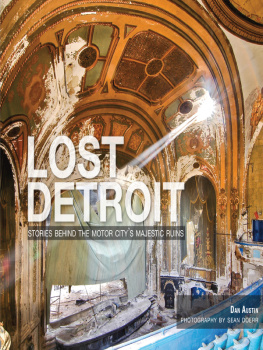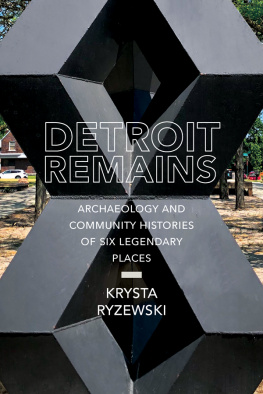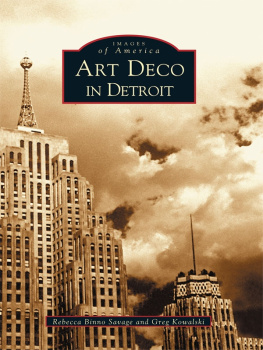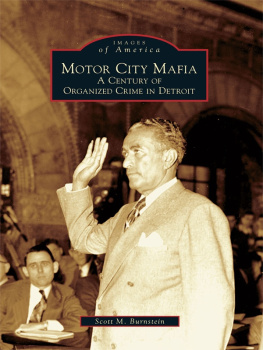

Published by The History Press
Charleston, SC 29403
www.historypress.net
Copyright 2010 by Dan Austin and Sean Doerr
All rights reserved
First published 2010
Second printing 2010
Third printing 2010
Fourth printing 2011
Fifth printing 2011
Sixth printing 2011
Seventh printing 2012
Eighth printing 2013
E-book edition 2013
Manufactured in the United States
ISBN 978.1.62584.237.4
Library of Congress Cataloging-in-Publication Data
Austin, Dan.
Lost Detroit : stories behind the Motor Citys majestic ruins / Dan Austin ; photography by Sean Doerr.
p. cm.
print edition ISBN 978-1-59629-940-5
1. Historic buildings--Michigan--Detroit. 2. Historic buildings--Michigan--Detroit--Pictorial works. 3. Abandoned buildings--Michigan-Detroit. 4. Abandoned buildings--Michigan--Detroit--Pictorial works. 5. Architecture--Michigan--Detroit. 6. Architecture--Michigan-Detroit--Pictorial works. 7. Detroit (Mich.)--Buildings, structures, etc. 8. Detroit (Mich.)--Buildings, structures, etc.--Pictorial works. 9. Detroit (Mich.)--History. 10. Detroit (Mich.)--History--Pictorial works. I. Doerr, Sean. II. Title.
F574.D48A2 2010
977.434--dc22
2010020764
Notice: The information in this book is true and complete to the best of our knowledge. It is offered without guarantee on the part of the author or The History Press. The author and The History Press disclaim all liability in connection with the use of this book.
All rights reserved. No part of this book may be reproduced or transmitted in any form whatsoever without prior written permission from the publisher except in the case of brief quotations embodied in critical articles and reviews.
To the city of Detroit:
Speramus Meliora; Resurget Cineribus
CONTENTS
FOREWORD
Architecture critics sometimes get so immersed in the jargon of their tradeentablatures and plinths and the likethat they forget that buildings get built for flesh-and-blood people. In this important book, Dan Austin and Sean Doerr have restored the real people to many of Detroits architectural landmarks, and not a moment too soon. The lost buildings of their title still stand, or rather totter, in a dilapidated state, their histories fading like the paint on their walls. The buildings themselves may not long survive. But thanks to this book and the efforts of Austin and Doerr, the stories of these buildings, and the stories of the people who built them and used them, will endure.
Who were these lost Detroiters? Mayors and matrons, train conductors and auto workers, honeymooners and jitterbugging young couples out for a Saturday nightall the rich panoply of faces that make up Detroits story. The buildings they inhabit in these pagesthe Michigan Central Station, Vanity Ballroom, Cass Tech High School and othersheld a central place in the story of Detroits Auto Century. It was Americas story, too. Detroiters lived, loved, toiled, played, celebrated and dreamed great dreams in these buildings and thereby helped shape a nation.
This book is blunt about the deterioration of these landmarks. But the reader need not fear or expect another of those dreary celebrations of ruins that came into vogue a few years ago. These structures stand today as ghost buildings, to be sure, and some of the photos may make you cry. But more often, the photographs here will have you staring in wonder at the splendor and the plenty of what once was.
So dont worry if you think architecture is beyond you, or if you dont know a frieze from a fresco. Austin and Doerr are good guides, gently leading the uninitiated through many rooms and hallways of Detroits all-but-forgotten story. Its a fascinating journey, well worth the price of a ticket.
John Gallagher
Detroit Free Press Architecture Critic
BRODERICK TOWER
Thousands of Detroiters once got their teeth drilled high in the sky above the bustling streets of downtown.
The Broderick Tower, one of the citys most recognizable skyscrapers, opened in 1927 as the Eaton Tower, named for what was then one of Detroits most recognizable families. Theodore H. Eaton came to Detroit in 1838 and invested his savings in a run-down drugstore that had folded in the Panic of 1837. At the time, Detroit was just an out-of-the-way frontier town of about eight thousand, but the twenty-three-year-old Eaton had pioneering in his blood: He was a direct descendant of Thomas Eaton, who helped settle the New World in 1660.
Eaton bought the Riley and Ackerly drugstore, a bet on Detroit that would pay off. He stockpiled paints, soaps and other supplies for the ships that came sailing into Detroit, often staying open late into the night so as to not miss a ship coming in, the Detroit Free Press noted in 1953. Eaton adapted his firm to Detroits changing business climate. As wool mills opened in the city, Eaton started selling them chemicals, dyes and machinery. He taught his son, Theodore H. Eaton Jr., the family trade, and the younger Eaton oversaw the company switch to selling dry cleaning supplies and heavy chemicals for the citys booming auto industry. But it was Berrien C. Eaton, the grandson of the companys founder, who would build a lasting monument to his familys legacy.
BUILDING A BEHEMOTH
Berrien Eaton took over the company in 1920 and also was a trustee of the Eaton estate. His father bought the site of the Broderick on May 25, 1904, then home to the Gladwin Building, a six-story structure built in 1896. The parcel is located on the southeastern corner of Grand Circus Park and Woodward Avenue, the citys main thoroughfare. Before the Gladwin, the land had been home to everything from the Grand Circus Hotel to Turkish baths.

The Broderick Tower in 1928, shortly after opening as the Eaton Tower. It was brilliantly illuminated at night and could be seen for miles. Advertisements for its office space declared it a beauty by daya jewel by night. Photo from the Detroit Free Press archives.

Today, the Broderick Tower is a ghostly specter looming over Grand Circus Park. The towering landmark closed in 1985, other than a restaurant space on the ground floor.

The crown of the Broderick silently towers 370 feet above downtown Detroit. It is one of the tallest abandoned buildings in the United States.
On July 10, 1926, Berrien Eaton announced that the estate would build a thirty-four-story, classically inspired shaft with elaborate Baroque-style ornamentation at the top. The family tapped architect Louis Kamper for the job, and his son Paul L. Kamper served as associate architect. The tab for the building came in at about $1.75 million (about $21.5 million today, when adjusted for inflation). Work started on the 370-foot behemoth of Indiana limestone on September 1, 1926, a building that would be a landmark worthy of Detroit and the street on which it stands, the Detroit News wrote in December 1926.
On March 3, 1927, Berrien Eaton drove the final rivet into the skyscraper bearing his familys name. Paul Kamper handed Eaton the red-hot metal during a ceremony on the thirty-third floor. When it opened about a year after it was announced, it was the second-tallest building in the city, behind the Book Tower. Starting in mid-May 1927, the top of the tower blazed forth with powerful floodlights illuminating the top four floors of its crown, the
Next page















